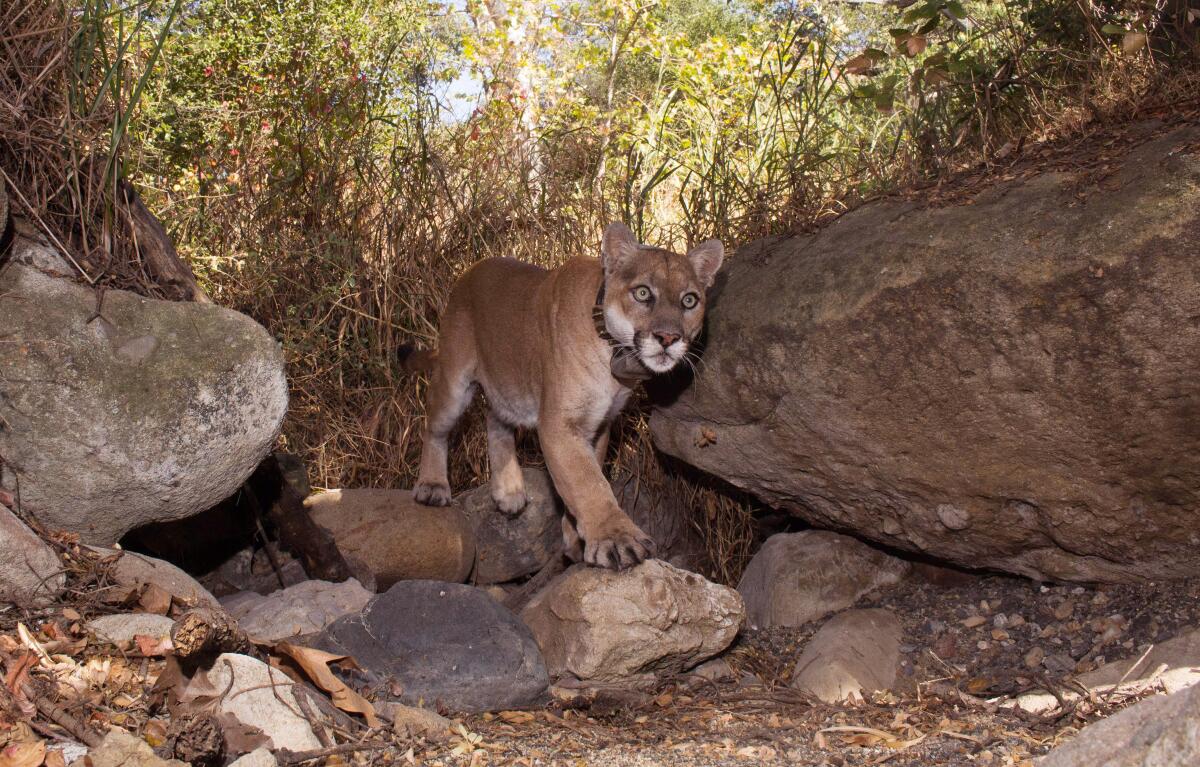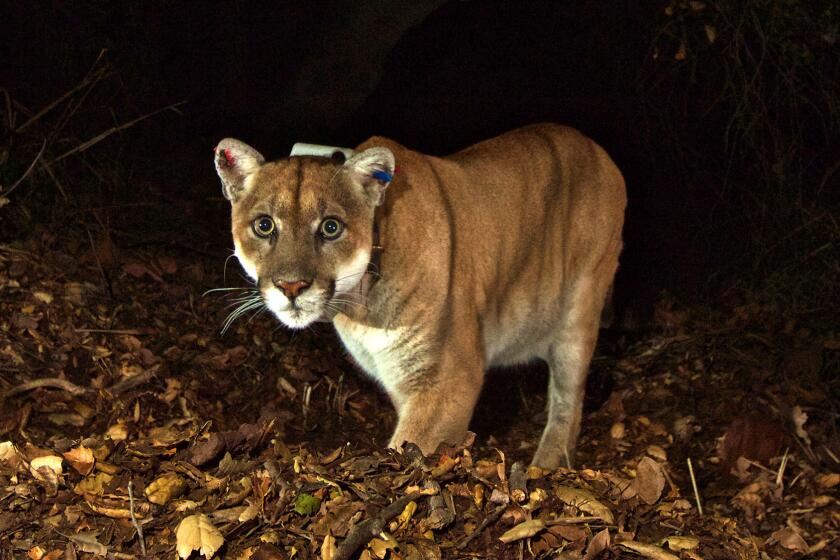Op-Ed: Elegy for a big, beautiful L.A. cat

- Share via
Like a lot of Angelenos, I found myself consumed last week by the fate of P-22, the mountain lion that, a decade ago, was discovered to have taken up residence in Griffith Park. On Monday, the big cat was sedated and captured in a Los Feliz backyard, after apparently having been hit by a car the night before. Aging and in failing health, he suffered a fractured skull, among other injuries.
I was buoyed when it appeared he would survive and be relocated to a nature preserve. But on Saturday morning, he was euthanized to deep and wide regret.
We understand — don’t we? — that we share our environment with wildlife. We recognize what the poet Robinson Jeffers once referred to as “transhuman magnificence.”
But P-22 signified something beyond that, something personal for Los Angeles. He signified something about how the city operates, what makes it distinct.
The mountain lion known as P-22 has become something of a celebrity in Los Angeles. After killing a chihuahua and acting erratically, he was found in a Los Feliz backyard and taken for evaluation.
On the one hand, there’s the matter of celebrity. Certainly, the 12-year-old cat fit the criteria — sought out by residents eager for a sighting, written up in publications including National Geographic. Just think of the iconic photos: P-22 passing below the Hollywood sign or standing on a crest overlooking the basin, with its sprawling nighttime lights.
Perhaps most telling: This newspaper prepared a prewritten “obituary.”
And yet, celebrity is fickle and it is fleeting. It’s far too shallow a gloss on P-22. What made this mountain lion essential for us was not that he was famous, but that he persevered.
To get to Griffith Park, P-22 had to migrate from the Santa Monica Mountains and may have crossed both the 405 and the 101 freeways. Once in the park, he beat the odds and stuck around for 10 years, making the “urban wilderness” of Los Angeles his home.
Isn’t that, to some extent, the case for all of us? Whether we arrived from elsewhere or were born here, we have built lives in this city not least by reckoning with its ferocity. Los Angeles is often caricatured as witlessly Edenic, “the City of Dreadful Joy,” in Aldous Huxley’s pointed phrase. But we know that’s just a stereotype, a convenient mythology of the place.
Instead of Huxley’s witless joy, let’s substitute wildness: a city in which nature vividly asserts itself. This begins with the instability of the landscape — the fires, floods, earthquakes and droughts. Among my favorite civic symbols are the La Brea Tar Pits, which sit in the midst of the metropolis like a harbinger of past and future, reminding us of where the city came from, what it will revert to.
And then there’s animal life, which is everywhere, from the scorpions and wolf spiders in the canyons to the possums I occasionally see in my driveway and the black widows in my garage.
During lockdown, I encountered a family of coyotes in my Mid-City neighborhood. They had come down to the flats for food, I imagined: I gave them a wide berth as I walked. Still, who am I to see them as interlopers? It if weren’t for our encroachment on their territory, they wouldn’t need to roam into ours.
The same might be said of P-22, who in coming to Griffith Park, enacted another never-ending Los Angeles story: leaving home, with all its limitations (the puma population of the Santa Monica Mountains is small and at risk for a variety of reasons, including the genetic effects of inbreeding), lighting out for new territory.
That instinct, that determination is just one reason P-22 was beloved, emblematic. He was one of us. His Los Angeles, like ours, could be a difficult city. Griffith Park was too small a hunting ground for a puma. He isolated himself when he braved the freeways. He would not find a mate.
All the same, he made do — or more than that. I would like to say that P-22 thrived. In so doing, he reiterated what I have long considered the key lesson of Los Angeles: The world is unpredictable and we have to adjust. Adapt, or else. This is Los Angeles defined.
All creatures come to an end; we know it. But that doesn’t make the ending easy.
When I learned P-22 was gone, I wept. This was not a matter of misplaced emotion; I was not projecting. I was mourning a local hero, beautiful, who made his own path and persevered.
Whatever else it is, Los Angeles is a place of aspiration. P-22 was part of that lineage, a saint of the city in the most elemental sense.
David L. Ulin is a contributing writer to Opinion.
More to Read
A cure for the common opinion
Get thought-provoking perspectives with our weekly newsletter.
You may occasionally receive promotional content from the Los Angeles Times.











